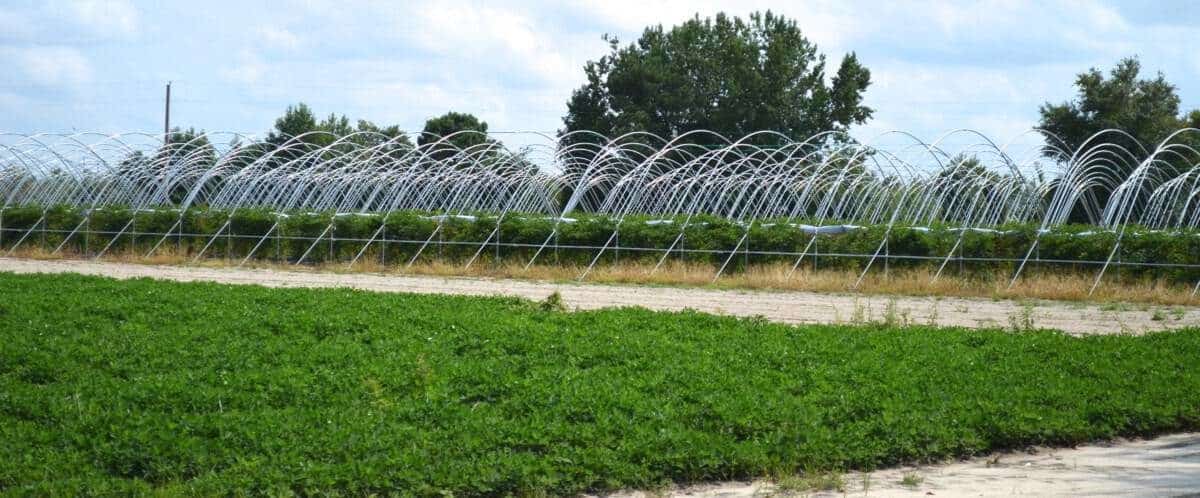
Agriculture represents one-sixth of North Carolina’s overall income. As is the case across industries, its workers need child care.
That’s been the aim of the East Coast Migrant Head Start Project (ECMHSP) since 1974 — to meet the care, education, and health needs of young children whose families work on farms across the state and region.
As the federal government shutdown continues, the 10 ECMHSP sites in the state and 43 centers across nine other states have been temporarily closed since the beginning of November. That leaves hundreds of North Carolina children without high-quality early care and education and many families without a reliable place to send their children while they work.
Head Start is funded through the U.S. Department of Health and Human Services (DHHS). So far, three grantees in North Carolina have had to temporarily close due to funding disruptions from the shutdown, including ECMHSP. Its North Carolina campuses were serving 250 children when they were forced to close, said ECMHSP CEO Javier Gonzalez.
“Farmworker families depend on us to provide a safe and healthy early childcare learning environment for their young children,” Gonzalez said in an email. “What parents are telling us now is that they are relying on inexperienced babysitters and family members to provide care for their children or they are missing work.”
Even without disruptions, the jobs and needs of migrant and seasonal farmworkers are ever-changing. ECMHSP assesses each of its sites annually so it can adapt its services, according to its 2025 community assessment report. The program adjusts the sites’ operating months and hours depending on the timelines of certain crops, the number of classrooms depending on where families are living, and the types of health, transportation, legal, and financial support it provides to families depending on their needs and their communities’ abilities to meet them.
EdNC reviewed the organization’s latest report, which outlines the program’s services from Nov. 1, 2023, to Oct. 31, 2024, serving 2,897 children with 42 centers and three family child care homes in Alabama, Florida, Georgia, Indiana, New Jersey, North Carolina, Oklahoma, Pennsylvania, South Carolina, and Virginia.
Take a look at North Carolina data below. To see information about specific centers, hover on the purple circles.
North Carolina is home to nine ECMHSP campuses and one family child care home that together serve 24 of the state’s counties. Note that some counties are served by more than one campus. In the map above, campuses are noted as dots, and counties served are shaded purple.
North Carolina’s service region enrolled 476 children in 2023-24. That number reflects cumulative enrollment over the course of the year and different agricultural seasons.
ECMHSP organizes most of their campuses into three service delivery areas. The North Carolina and South Carolina regions make up “service delivery area one” and collectively provide services to 40 counties across North Carolina, South Carolina, Virginia, and Maryland. North Carolina’s region includes two Virginia-based campuses. The Cheriton Campus serves Northampton County, and the Parksley Campus serves Accomack, Virginia and Somerset, Maryland. Two North Carolina campuses, Hendersonville and Whiteville, are organized under the South Carolina region.
National trends
Across all ECMHSP sites, children represent nineteen different countries. The majority — 82% — were born in the United States. Children from Mexico make up the next largest group at about 5% of all children. Parents represent 21 different countries — 48% of parents are from Mexico, 14.5% are from Guatemala, 14% are from Haiti, and 12.8% are from the U.S.
The federal 2024 Appropriations Act expanded eligibility for ECMHSP services, removing prior restrictions based on federal poverty guidelines and the maximum income a family could earn to be eligible.
According to the ECMHSP report, this eligibility expansion took effect in March 2024 and created more opportunities for families to enroll in an ECMHSP campus.
Enrollment across all ECMHSP sites remained steady in all of their service areas during between 2023 and 2024, and the expanded family eligibility suggests this trend will continue.
In the programs’ 2023-24 operating year, seven regions and 32 campuses met their funded enrollment goal — an overall increase from the previous year. At the same time, families at campuses across ECMHSP noted in the report that it would be helpful to extend campuses’ operating seasons so that they are better synced with school district calendars, other child care service calendars, and their communities’ local agricultural season.
![]() Sign up for Early Bird, our newsletter on all things early childhood.
Sign up for Early Bird, our newsletter on all things early childhood.
The annual report relies on parents’ voices to identify emerging trends across their campuses. Based on this feedback, access to health care and quality housing conditions surfaced as challenges affecting ECMHSP families.
Barriers to medical care remain a challenge to children’s health, per the report, as often the medical systems ECMHSP parents encounter are not adapted to their needs. Provider shortages in Medicaid-accepting providers, medical specialists, and behavioral health services create few opportunities for medical attention. Insufficient transportation and language access services add to these challenges.
Despite these challenges, in 2024 94% of ECMHSP children had access to a medical provider. The report explains that this success “is attributable to existing medical and dental service agreements and the fact that most children (81%) qualified for Medicaid in the state in which they were enrolled.”
Improvements in standardized service delivery and early screening efforts also meant 97% of the 115 children identified with a disability received specialized services to address their needs.
Affordable housing remains a significant issue, too, for ECMHSP families. Rising rent and interest rates in service areas limit families’ housing options and limit their access to both health care and public transportation. The report also highlights limited opportunities for children to engage in physical activity, an activity closely tied to children’s mental well-being, because families’ homes have minimal access to playgrounds, parks, and green spaces.
Based on agricultural and residential trends — plus a lack of transportation — ECMHSP opened its first family child care homes in 2022-23, which are child care programs operated in providers’ residences. Home-based programs serve fewer children and mixed ages, making rural areas with low numbers of children a common fit for the model.
The organization also hired family child care home specialists to support the family child care provider, who is normally the only educator in the home, and to connect families with local resources.
In the first two years implementing the model, the report says specialists who did not live in the communities they served struggled to develop connections with local networks. ECMHSP operated three family child care programs in 2023-24, one in North Carolina and two in South Carolina.
“Overall, the Family Child Care Home model is a vital service innovation, ensuring that ECMHSP continues to meet the needs of families in dispersed rural areas,” the report says. “However, the trends and challenges identified in the first two years highlight areas for further investment, such as improving access to local resources, addressing health disparities, and enhancing the capacity of specialists to serve rural communities effectively.”
North Carolina trends
ECMHSP sites serve children in families working in vineyards, chicken hatcheries, nurseries, and tobacco, blueberry, strawberry, blackberry, and sweet potato farms across North Carolina.
Closely mirroring overall ECMHSP trends, 80% of those children in 2023-24 were born in the U.S., 8% were from Mexico, and about 4% were from Honduras. About 65% of their parents were from Mexico, 10% were from the U.S., and 10% were from Haiti.
Most children and families spoke Spanish, but programs were adjusting as the diversity of spoken languages increased.

Most families were seasonal workers (72%), meaning their work depends on the season, while 28% were migrant workers, meaning they travel to find work.
As is the case across ECMHSP sites, transportation was a barrier to families accessing many North Carolina programs. Many sites reported that unreliable transportation hinders children’s consistent attendance. The centers provided transportation to a little more than half of children, and 11% said they needed transportation but did not receive it. In some cases, centers reported difficulties finding bus drivers.
Center staff reported long waiting lists for health and dental care for children. High costs of living, from housing to groceries, also contributed to housing and food insecurity, the report found.
Every site served children experiencing homelessness; at multiple sites, more than 30% of children enrolled were experiencing homelessness.
Like in child care programs across the state and country, staffing challenges disrupted care. In Rocky Point, for example, staffing challenges led to infants and toddlers not being served. In Hendersonville, the program could not serve infants for the same reason.
Despite these challenges, centers connected children and families with community resources. The ECMHS site in Bailey partnered with Nash Community College to provide free English as a second language (ESL) courses to all of its families. ECMHSP employees in Angier provided legal assistance and counseling. Staff also connected families to other early childhood options in the area, including other Head Start programs and NC Pre-K classrooms.
In Hendersonville, where ECMHSP served 70 children in 2023-24, 21 of which were experiencing homelessness, the program adapted to meet families’ needs in the aftermath of Hurricane Helene.
Following the hurricane, the site’s operations were disrupted because of limited access to water, food, and electricity. The staff, according to the report, “quickly implemented temporary adjustments to ensure the safety and well-being of children and families.”
The storm had a severe impact on families’ jobs.
“Flooded fields, destroyed crops, and damaged transportation routes led to job interruptions, exacerbating existing challenges such as food insecurity and limited healthcare access,” the report says.
None of the families served were displaced, though those in temporary housing were still vulnerable at the time of the report. The disaster underscored the necessity of the program, staff reported.
“Children were particularly affected, experiencing disruptions to their routines, feelings of insecurity, and the emotional toll of witnessing their parents’ struggles,” the report says. “These challenges reinforced the importance of our program as a safe haven, providing stability, normalcy, and support during a time of uncertainty.”
Recommended reading




